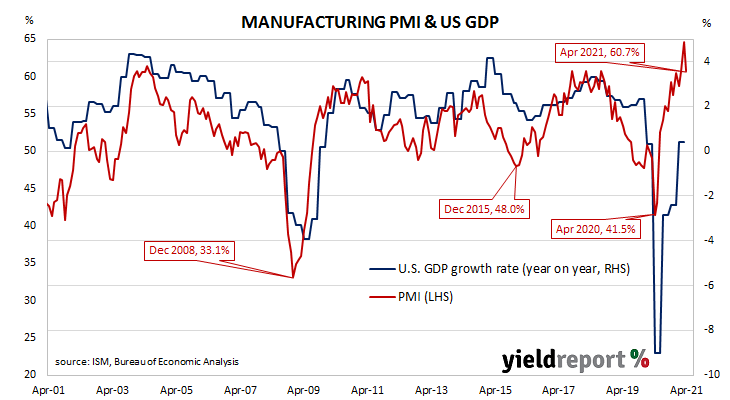Summary: ISM purchasing managers index (PMI) down; below consensus expectation; reading “still very expansionary”; supply side “key factor” behind decline, “momentum building”; implies US economy still growing at rapid pace.
US purchasing managers’ index (PMI) readings reached a cyclical peak in September 2017. They then started a downtrend which ended in March 2020 with a contraction in US manufacturing which lasted until June 2020. Subsequent month’s readings implied growth had resumed and the early months of 2021 have provided elevated readings.
According to the latest Institute of Supply Management (ISM) survey, its Purchasing Managers Index recorded a reading of 60.7% in April. The result was below the generally expected figure of 65.1% and lower than March’s reading of 64.7%. The average reading since 1948 is 52.9% and any reading above 50% implies an expansion in the US manufacturing sector relative to the previous month.
“The ISM manufacturing was a big miss… but details in the report showed supply and inflationary pressures continue to intensify,” said NAB currency strategist Rodrigo Catril.

Longer-term US Treasury bond yields fell on the day while shorter-term yields remained stable. By the close of business, the 2-year Treasury bond yield remained unchanged at 0.16%, the 10-year yield had lost 3bps to 1.60% while the 30-year yield 1bp lower at 2.29%.
ANZ economist Rahul Khare noted the latest reading is “still very expansionary” and “still consistent with a vigorous US recovery.
Purchasing managers’ indices (PMIs) are economic indicators derived from monthly surveys of executives in private-sector companies. They are diffusion indices, which means a reading of 50% represents no change from the previous period, while a reading under 50% implies respondents reported a deterioration on average. According to the ISM, a reading “above 42.8%, over a period of time, generally indicates an expansion of the overall economy.”
Khare pointed to changes on the supply side as “the key factor behind the retracement, with backlogs at a record high, inventories down, and materials prices pushing higher.” All industries reported growth, “a sign that there is real momentum building in the US.”

